In the Spring of 2009, this blog went up. Blogging about fountain pens has been the thing I’ve done as a break from writing other kinds of stories. Writing about pens has often been a kind of restful vacation.
Writing with fountain pens is even better.
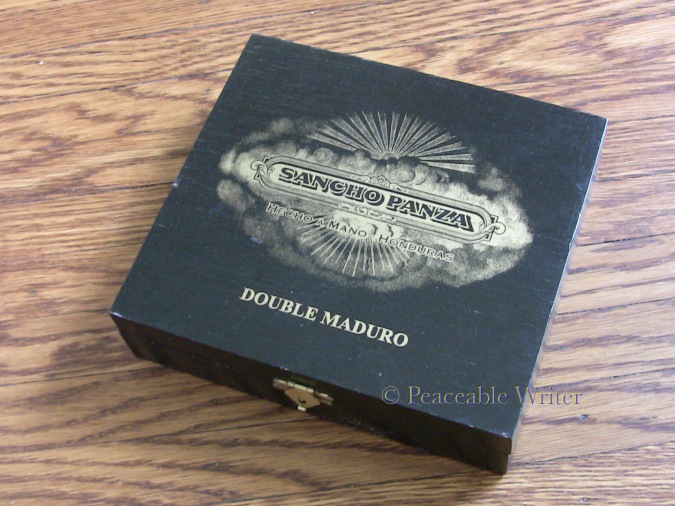
DIY 9-pen storage box now holds 8 fountain pens
The intent of this blog has never been commercial, has never been to make money off your readership, to brag or to even sell you on the things that I love. The intent has been to share my own pen obsessions, provide good information in some cases, and to talk about my own process for acquiring pens, paper and ink.
When I first started blogging about pens, there were very few blogs sharing the quirky things I found intriguing. I wanted to make it easier for others to find what I sometimes had difficulty discovering. Today, blogs are everywhere as a new welcome generation embraces fountain pens.
My pens are not better than yours. My pens are best for me.
Over the years, my preferences around writing tools have certainly evolved, and no doubt will continue evolving. From thin to fatter pens; to super-extra-fine points, to more broader nib points; to seeking the best notepads segueing into making my own; and to finding a set of inks that don’t break my budget for everyday use.
As someone who usually treads softly on the earth, I’ve been disappointed in my attempts to reduce my environmental footprint around fountain pens. The inks that work best for me travel a long way from Japan. Even buying pens from custom pen makers involve materials that often are manufactured overseas. I want to buy local yet, for many of us fountain pen lovers, local buying is not possible. (If you don’t know what I’m talking about, or why, kindly check out the Story of Stuff.) Sometimes the retail price in our own countries is not very good compared to eBay or buying direct from a company in another country.
Often the distribution model for goods feels grossly outdated.
The truth is we live in an ever-changing, connected, often interdependent, global society. I love that about our world. It’s really quite small, isn’t it? Amid all the noise, the internet has brought so many of us closer together—across countries, across interests, across world views.
Meanwhile, posts here have been varied: from an analysis of an old Conklin catalog (hey, that post became a footnote in Alfred Mur’s The Conklin Legacy!), to a look at the history of Visconti Ragtimes, and to a bit about Sheaffer’s WASP Addipoint pens.
Sometimes after writing in-depth about a pen, such as the Pilot Fermo, or a Montblanc, or even an Edison custom, it somehow gets released in my mind. Consequently, the pen ends up being re-homed. Always a surprise how that process works on me.
Pen minimalism has been a conscious choice. But not so minimal as to have only one pen. Where’s the fun in that?
In smaller numbers now, six fountain pens make up are the core of my everyday writing instruments. The two most favored remain the Edison Huron, and my baby Danitrio Cumlaude.
The Edison Huron I’ve had the longest: going on seven years now. The Huron was among the first Hurons Brian Gray made. It uses a Bexley nib unit, predating when Edison took on JoWo nibs, feeds and collars. The Huron’s yellowstone acrylic still evokes pebbles beneath a flowing creek.
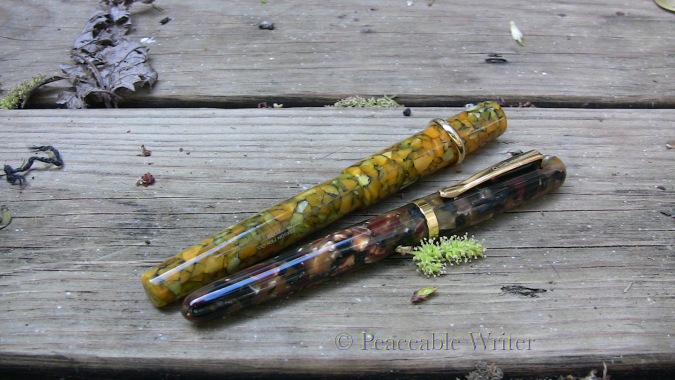
Edison Huron Yellowstone, baby Danitrio Cumlaude Brown Marble (aka Sheaffer Amber Glow)
Then again, all six of my remaining “core” or writing pens have a favorable place in my pen hoard. The Bexley BX802 for its gorgeous caramel ice-cream invocation. The Newton Shinobi for “best pen ever” appeal with its #3776 nib, and endless ink tank. The Newton Gibby aka Banana Slug for how it reminds me of beloved Redwood forests. The Hakumin Edison Mina for its personal significance, beauty, and outstanding writing qualities.
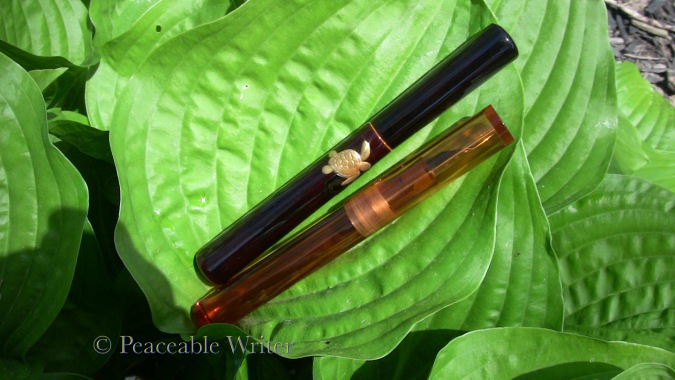
Hakumin Edison Mina, Newton Shinobi Copper
There are occasions I wish the fine nib of my Shinobi were a medium. Or that all my nibs were stubbed. Or that a particular pen were longer. Or… well, you see, dissatisfaction can be an endless state of mind.
Take a deep breath, pick up a pen, get to writing, and dissatisfaction disappears.
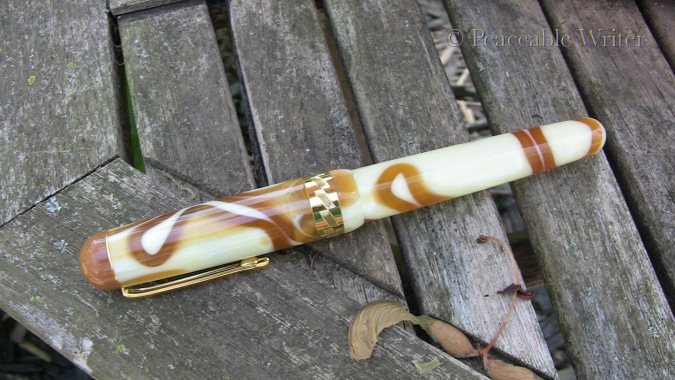
Bexley BX802 Cappucino
Each pen expresses itself differently in the hand, nib to paper. This group of fountain pens makes me quite happy.
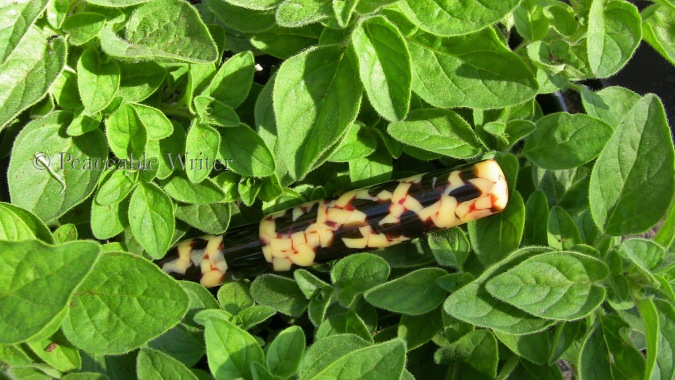
Newton Banana Slug, Kinney CI 18K nib, inked with Platinum Mix Free Olive Oil
There are two note-taking pens instead of one: the MYU 701 and a Pilot Decimo. The MYU is the most discreet pen of the two, but I love the VP/Decimo capless nib way too much to be without one. In fact, the Decimo has multiple nib units, a Kinney CI, of course, as well as a Fine and a Broad nib unit. (A Broad nib? Yes, thinking it’ll make a nice Kinney custom italic.)
Multiple nibs are a cool thing about some pens. The Huron and BX802 have multiple nibs, too.
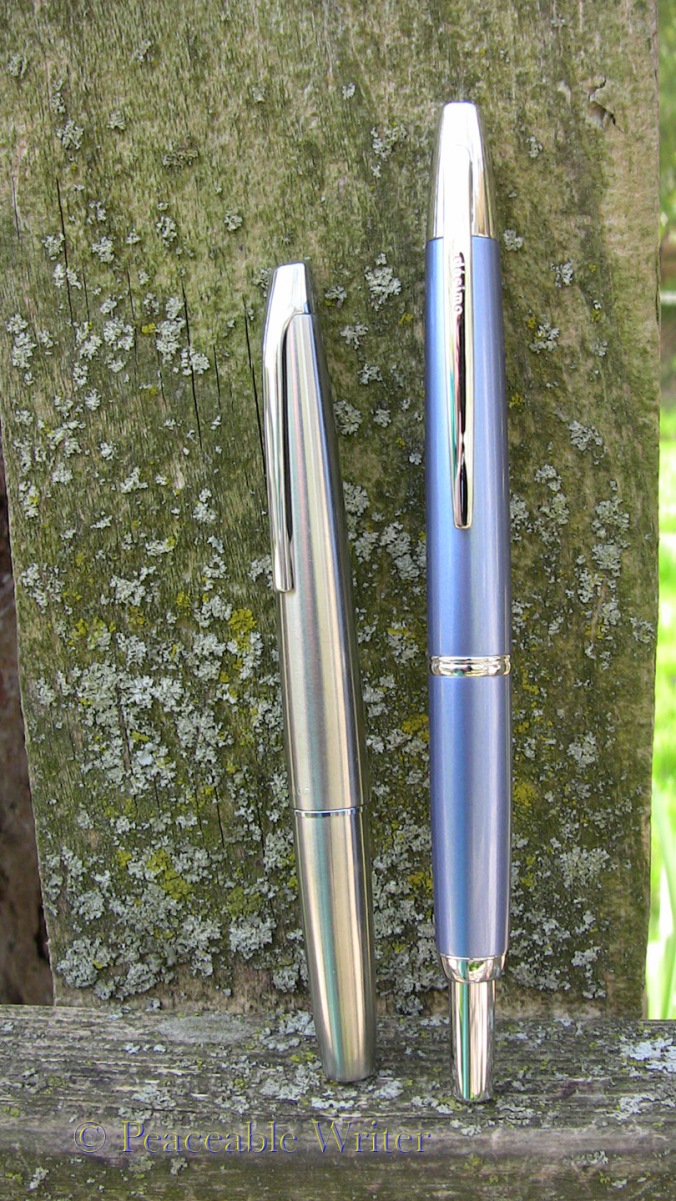
MYU 701, Pilot Decimo
After the Pilot capless nib, my favorite nib among my pens is from the “slush pile.” That’s the group of pens that come as gifts, or as visitors.
Slush pile? Is that a sacrilege?
A soft-medium Nakaya nib is one of the most inviting nibs in my possession. A Nakaya Tortoiseshell Chinkin was given to me with an SEF nib that was superb—but way too fine for my aging eyes. I agonized over what to do with this beautiful gift, until finally succumbing to swapping the nib out for the soft-medium.
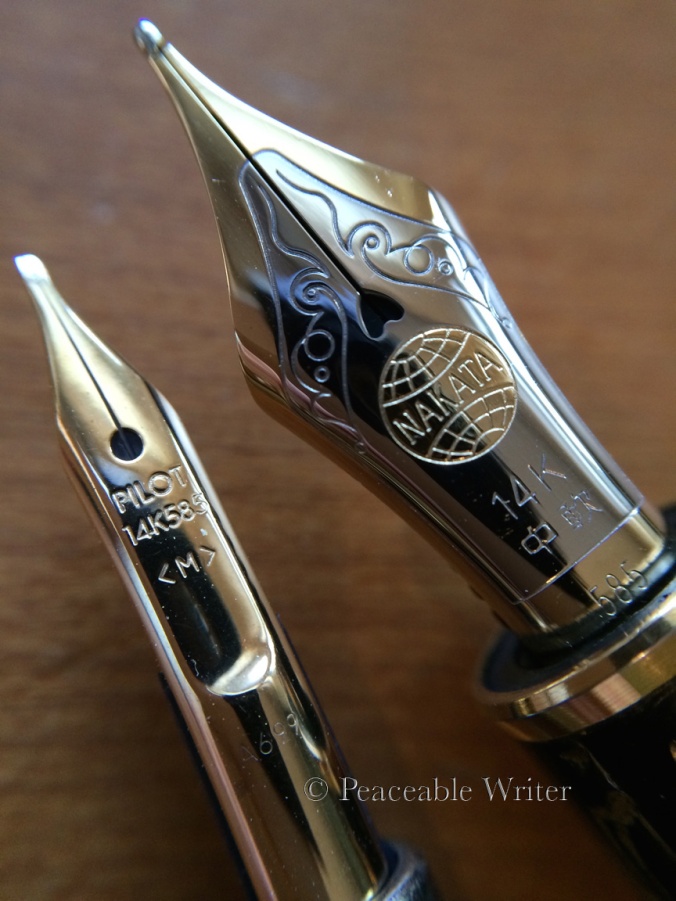
Pilot w/Kinney CI, Nakaya Two-Toned Soft-Medium
Those two nibs—the Pilot capless and the Nakaya—are my absolute favorites. That leaves the other nibs as simply really, really nice. I like that the nibs are all different. This writer cannot abide by too much uniformity.
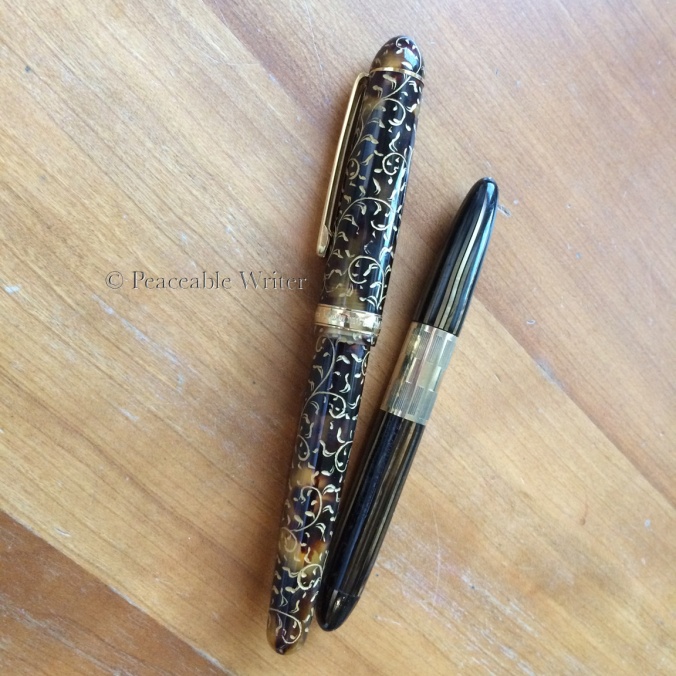
More brown pens! Nakaya Tortoiseshell Chinkin Karakusa, Sheaffer Tuckaway
My oldest, and most vintage pen: a Sheaffer Tuckaway. It belonged to my best friend’s father. Tuckaways are cool. The next oldest pen is the MYU 701. Decades apart—1942 to 1999—both pens were created to serve a portable purpose.
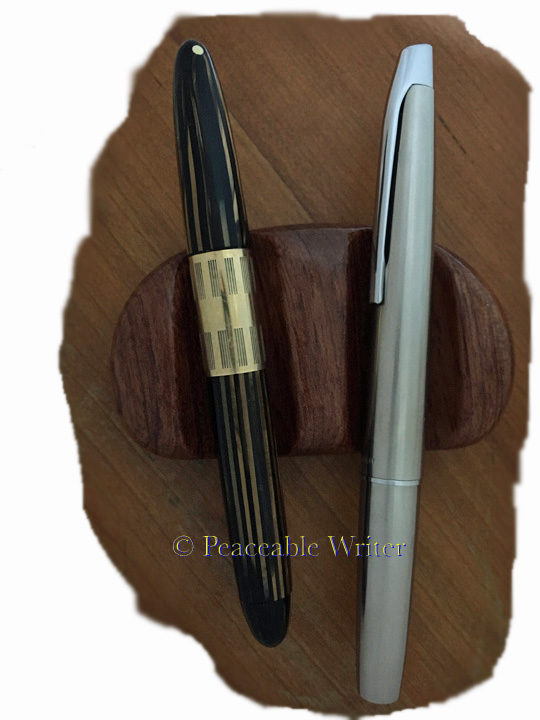
Pens over 50 years apart in age: Sheaffer Tuckaway, Pilot MYU
I still like to write first drafts by hand. Writing drafts in that way, though, has been easier when writing scripts—lines and lines of dialogue. Writing prose by hand is more challenging. (I do my own typing, ya know.) Yet, I remain committed to that thoughtful connection to the creative flow that happens when you put the nib to paper.
Over the years, the blog has gained a readership from around the world. I’m grateful for all of you, and hope there’s much that resonates for you in these posts. I too enjoy reading the variety of thoughts in your blogs and forums, even if sometimes a web translator has to be engaged. I’m deeply thankful for those of you I’ve actually met—all because of fountains pens!
This is not a good-bye post, but a “I’m taking a very long break” post. For a few months, perhaps until the end of the year. All that Chronodex time tracking has informed me well.
It’s time to shut-up about fountain pens and just use them.
Current commitments and deadlines leave nary enough time for pen blogging. At least not in the way I enjoy blogging. There are a few drafts of posts that remain undone: more thoughts about ink capacity, filling mechanisms, and an in-depth post about Edison pens among them. Perhaps early next year, ay?
Someone I knew liked to tweak a familiar saying into this:
Talking about pens is like dancing about architecture.
Very true.
Happy writing, my friends.
Stay kind and curious!
Related PW posts:
- Edison Huron
- Hakumin Edison Mina
- Newton Shinobi
- Newton Banana Slug
- Pilot Decimo & MYU 701
- Bexley Pens
- DIY Storage Box
- Going Indie with Notebooks
- The Tiny Pen Hoard
For outstanding information about Japanese pens, please read Crónicas Estilográficas (best blog ever).
For the best experiential fountain pen blog, please read Penucopia.
- Keep the pen collection small.
- Use a refillable pen.
- Repair things that break whenever possible.